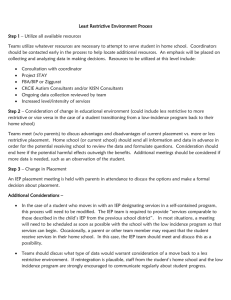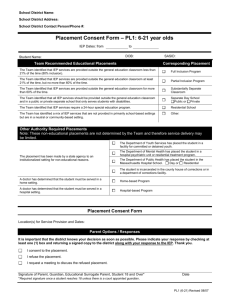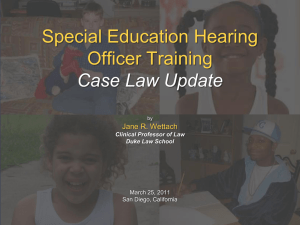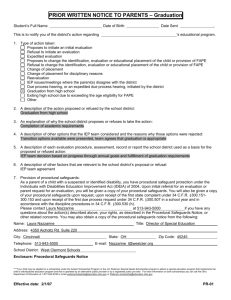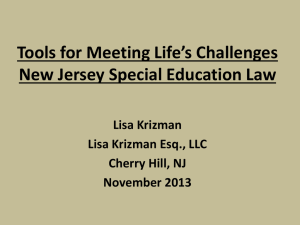IDEA Cases (EDL 277)
advertisement
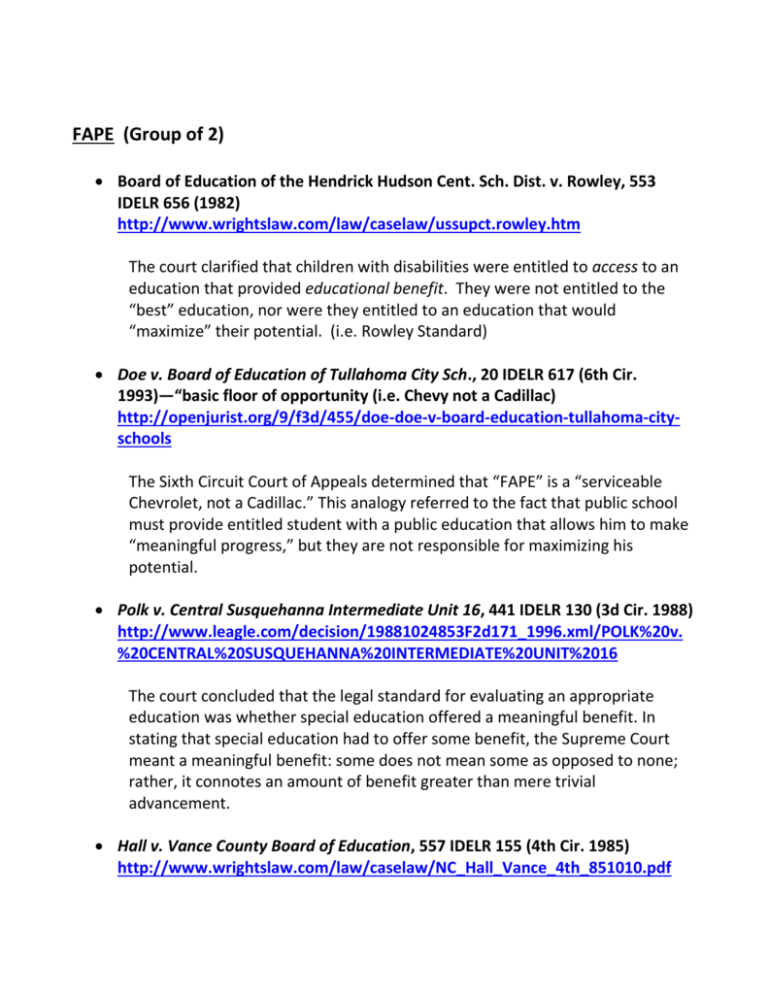
FAPE (Group of 2) Board of Education of the Hendrick Hudson Cent. Sch. Dist. v. Rowley, 553 IDELR 656 (1982) http://www.wrightslaw.com/law/caselaw/ussupct.rowley.htm The court clarified that children with disabilities were entitled to access to an education that provided educational benefit. They were not entitled to the “best” education, nor were they entitled to an education that would “maximize” their potential. (i.e. Rowley Standard) Doe v. Board of Education of Tullahoma City Sch., 20 IDELR 617 (6th Cir. 1993)—“basic floor of opportunity (i.e. Chevy not a Cadillac) http://openjurist.org/9/f3d/455/doe-doe-v-board-education-tullahoma-cityschools The Sixth Circuit Court of Appeals determined that “FAPE” is a “serviceable Chevrolet, not a Cadillac.” This analogy referred to the fact that public school must provide entitled student with a public education that allows him to make “meaningful progress,” but they are not responsible for maximizing his potential. Polk v. Central Susquehanna Intermediate Unit 16, 441 IDELR 130 (3d Cir. 1988) http://www.leagle.com/decision/19881024853F2d171_1996.xml/POLK%20v. %20CENTRAL%20SUSQUEHANNA%20INTERMEDIATE%20UNIT%2016 The court concluded that the legal standard for evaluating an appropriate education was whether special education offered a meaningful benefit. In stating that special education had to offer some benefit, the Supreme Court meant a meaningful benefit: some does not mean some as opposed to none; rather, it connotes an amount of benefit greater than mere trivial advancement. Hall v. Vance County Board of Education, 557 IDELR 155 (4th Cir. 1985) http://www.wrightslaw.com/law/caselaw/NC_Hall_Vance_4th_851010.pdf The court found that Rowley allowed for a case-by-case determination of what substantive standards met the criteria that an IEP was to be reasonably calculated to enable the student to receive educational benefits. In this case, test scores indicated that minimal progress had been made. In light of the student's intellectual potential the court found minimal results to be insufficient. The court stated that Congress certainly did not intend for a school system to provide a program that produced only trivial academic advancement. Child Find/Evaluation (Group of 1) Department of Education V. Cari Rae (D.Hawaii 2001) 158 F.Supp.2d 1190, 1194 http://www.leagle.com/decision/20011348158FSupp2d1190_11231.xml/DEPA RTMENT%20OF%20EDUC.,%20ST.%20OF%20HAWAII%20v.%20CARI%20RAE%2 0S. A district’s IDEA obligation to evaluate a student, either through its child find or referral processes, is triggered when the district has reason to suspect a disability, and reason to suspect that special education services may be needed to address that disability Timothy W. V. Rochester New Hampshire, Sch. Dist., 875 F.2d 954 (1st Cir.) http://www.leagle.com/decision/19891829875F2d954_11671.xml/TIMOTHY%2 0W.%20v.%20ROCHESTER,%20N.H.,%20SCHOOL%20DIST. No child is too disabled to be educated. This case established a “Zero Reject Rule.” Meaning all children are eligible even if she/he is considered uneducable. Least Restrictive Environment (LRE) (Group of 2) Daniel R.R. v. State Board of Education, 874 F.2d 1036 (5th Cir. 1989) http://www.kidstogether.org/right-ed_files/daniel.htm This court, relying on Roncker, also developed a two-part test for determining if the LRE requirement is met. The test poses two questions: (1) Can an appropriate education in the general education classroom with the use of supplementary aids and services be achieved satisfactorily? (2) If a student is placed in a more restrictive setting, is the student "integrated" to the "maximum extent appropriate"? (Standard in AL, DE, GA, FL, LA, MS, NJ, PA, TX). Oberti v. Clementon, 995 F.2d 1204 (3rd Cir. 1993) http://www.kidstogether.org/right-ed_files/oberti.htm This is the case that begins the change from the IDEA's "mainstreaming" approach to the concept of "inclusion." Clearly, inclusion is judge-made law, not legislative action. Rafael Oberti was an autistic student who was disruptive in his general classroom placement, and the school wanted to move him to a more restrictive placement. The court held that "inclusion is a 'right,' not a privilege for a select few. Success in special schools and special classes does not lead to successful functioning in integrated society, which is clearly one of the goals of the IDEA." Remember that the word "inclusion" did not appear in the IDEA; it is a judge-made law. Board of Education, Sacramento City Unified School District v. Rachel H., 14 F.3d 1398 (9th Cir. 1994) http://www.kidstogether.org/right-ed_files/rachel.htm Rachel Holland was a third-grade student with an IQ of 44. Her parents argued that with appropriate aids and services, she could be educated in the general classroom. The court ruled that in determining the appropriate placement, the educational benefits of the general education classroom with supplemental aids and services must be compared to the educational benefits of the special classroom. The nonacademic benefits of interaction with nondisabled students also must be considered. Further, the effect of the student's presence on the teacher and on other students must be evaluated. This three-pronged test is often called the Holland test.This case is the high-water mark of the inclusion movement. (Standard in AS, AR, CA, HI, ID, MT, NV, OR, & WA). Light v. Parkway 41 F.3rd 1223 (8th Cir. 1994) http://leagle.com/decision/1994126441F3d1223_11088.xml/LIGHT%20v.%20P ARKWAY%20C-2%20SCHOOL%20DIST. Lauren Light was "violent, dangerous, and disruptive" in her general classroom placement. Her school behavior included 30 incidents of violence that caused her classmates to seek medical attention from the school nurse. In rejecting the parents' request for a "stay-put" and a return to the general classroom, the court held, "A student who is violent, dangerous, and disruptive of the education of others is never properly placed in a regular classroom setting." This case marked a turn in the judicial belief that inclusion is a right. Further, the court indicated that all of the circumstances surrounding a student must be taken into account when determining the proper placement. For some students, a general classroom may not be appropriate even with aids and services. Individualized Education Program IEP (Group of 3) Burlington Sch. Comm. v. Massachusetts Dept. of Educ., 556 IDELR 389 (U.S. 1985) http://www.wrightslaw.com/law/caselaw/ussupct.burlington.htm Court clarified procedural safeguards, parent role in educational decisionmaking; tuition reimbursement for private placement; child's placement during dispute about FAPE. Decision illustrates how the statement of goals in an IEP can be used to assess the adequacy of the program the school provided. Spielberg v. Henrico County Public School, 441 IDELR 178 (1988-89 EHLR 441:178) (4th Cir. 1988) http://openjurist.org/853/f2d/256/spielberg-spielberg-v-henrico-countypublic-schools#fn3_ref Court found that the school district formed the intent to change the placement for a 19-year-old student with autism and profound mental retardation from an out-of-state private residential placement to an in-state public day program. Having decided to transfer the student, the district then conducted a reevaluation supporting its conclusion and convened an IEP meeting to revise the IEP accordingly. All this occurred shortly after an annual IEP meeting confirming the student’s need for residential placement. The court found, and the 4th circuit confirmed, that the IDEA forbids such predetermination because the proposed change in placement was made without regard to student’s individual needs. (i.e. shoehorning or predetermination) Larson by Larson v Independent School District No. 361, 40 IDELR 231 (D. Minn. 2004) http://www.wrightslaw.com/law/caselaw/case_Kerr_ISD_318.html District court ruled that IEP failed to adequately provide the student’s present level of performance and objective criteria against which achievement could be measured. The “present level of performance” sections of the IEP contained only conclusory statements about the student’s abilities, and the IEPs did not fully explain how his disability affected his involvement in the educational process. Court awarded compensatory education of 225 minutes direct special education services and a private assessment. Amanda C. v. Clark Co Sch. Dist. & Nevada Dept. of Ed (9th Cir. 2001) http://www.wrightslaw.com/law/caselaw/2001/9th.amandaj.clarkco.nevada. htm Court cites research about ABA/Lovaas treatment; describes purposes of the IDEA; IEPs and procedural safeguards. District's failure to provide parents with evaluations adversely affected parents' ability to make decisions and damaged child; district failed to provide FAPE; standard of review in two-tier system; credibility of witnesses. Evans v. Rhinebeck Central Sch Dist, (S.D. NY 1996) http://www.wrightslaw.com/law/caselaw/case_Evans_Rhinebeck_FAPE.html Excellent case about tuition reimbursement, procedural and substantive issues, FAPE, dyslexia, objective measurement of progress. The IEP must include measurable criteria to assess the student’s progress M.L. v. Federal Way School District (WA) (9th Cir. 2004) http://www.wrightslaw.com/law/caselaw/04/9d.ml.fedway.wa.htm Court found that the failure to include a regular education teacher on the IEP team was a serious procedural error that led to a loss of educational opportunity and a denial of FAPE. Procedural Safeguards and Parent Participation (Group of 2) Deal v Hamilton County Board of Education, 42 IDELR 109 (6th Cir. 2004) http://www.wrightslaw.com/law/caselaw/04/6th.deal.hamilton.tn.htm District court ruled district denied parents opportunity to meaningfully participate in the IEP process when it placed their child in a program without considering his individual needs. The 6th Circuit Court concluded that, although the parents were present at the IEP meetings, their involvement was merely a matter of form and after the fact because the district had, at that point, pre-decided the student’s program and services. Doug C. v. Hawaii, (9th Cir. 2013) www.wrightslaw.com/law/caselaw/2013/9th.doug.c.v.hawaii.pdf Court ruled that the failure to include the parent at the IEP meeting violated the procedural requirement of IDEA and invalidated the IEP. In quoting a 2003 Ninth Circuit case, the Court explained that “We held that parental “involvement in the ‘creation process’ requires the [agency] to include the [parents in an IEP meeting] unless they affirmatively refused to attend.” Buser v. Corpus Christi Indep. Sch. Dist., 20 IDELR 981 (S.D. Tex. 1994), affd, 22 IDELR 626 (5th Cir. 1996) http://caselaw.findlaw.com/us-5th-circuit/1086662.html Court ruled that even though parents are “equal participants in the IEP process, they do not have veto power. The IDEA does not allocate “one vote” each to the school district and parents; parents do not have an equal vote in formulating an IEP. Justin Knable v. Bexley City Sch. Dist. (6th Cir. 2000) http://www.wrightslaw.com/law/caselaw/2013/9th.doug.c.v.hawaii.pdf A school district's failure to comply with the procedural requirements of the Act will constitute a denial of a FAPE only if such violation causes substantive harm to the child or his parents. Substantive harm occurs when the procedural violations in question seriously infringe upon the parents' opportunity to participate in the IEP process. Discipline (Group of 2) S-1 v. Turlington, 552 IDELR 267 (5th Cir. 1981) The mere fact that a student with a disability knows right from wrong did not make his misconduct unrelated to his disability. Doe v. Maher, 793 F.2d 1470 (9th Cir.1986) http://www.leagle.com/decision/19861582795F2d787_11445 The Court established the standard in determining the nexus between conduct and disability is “conduct that is caused by, or has a direct and substantial relationship to, the child’s handicap. Put another way, a handicapped child’s conduct is covered by the definition only if the handicap significantly impairs the child’s behavioral controls.” Honig v. Doe 559 IDELR 231 (U.S. 1988) http://www.wrightslaw.com/law/caselaw/ussupct.honig.doe.htm Supreme Court prohibited certain disciplinary actions that result in a change of placement for a student with disabilities. Generally, an entitled student cannot be suspended for more than 10 school days of his misconduct was caused by, or was related to his disability. If the misconduct includes bringing a weapon or drugs to school, if the student has inflicted serious bodily injury on another person, or if he otherwise poses a danger to himself or other, different rules apply. In all events, suspensions of more than 10 school days are subject to special rules and limitations when the student is disabled under either the IDEA or Section 504. District must continue to provide educational services. Community Consolidated Sch. Dist. #93 v. John F. (IL 2000) http://www.wrightslaw.com/law/caselaw/IL_dist93_johnf_00_10.pdf It was reasoned that several procedural errors were made by the school district to deprive John of FAPE under the IDEA. John’s parents were entitled to a notice that the school district would consider a change in his placement at earlier hearings so they could prepare for those meetings. It was also reasoned that the school district found that John’s violation was a manifestation of his disability and should have amended his IEP and behavior plan. If the school district decided that John’s placement was not meeting his needs, it should have considered several other options. Lastly, it was reasoned that homebound tutoring was not a legal placement under the IDEA and his parents’ agreement to this option was not truly an agreement because they were not presented with any other options. The district had no right to remove John as a disciplinary consequence of offenses involving drugs and weapons. The procedures the district followed after the parents objected to their son’s placement were confusing. The school district failed to clearly explain the parents’ procedural rights to due process.
